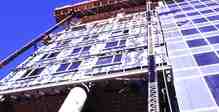
Department of Building, Civil
and Environmental Engineering
Concordia University
Montreal, Quebec, H3G 1M8

The Environmental Chamber has been established as a multi-purpose testing facility to evaluate the performance of full-scale building envelope systems. Its key sub-systems include: structural components, heating, cooling and humidification systems, control systems, sensors and instrument, data acquisition, and supporting setup and apparatus.
| (Click to view a larger image) | ||
The Environmental Chamber consists of a cold box for simulating Canadian winter climates, a hot box for providing indoor conditions, two specimen frames to hold specimens, and a metering box for measuring heat flux according to ASTM C-236 method. Full-size envelope assemblies up to 4m wide by 7 m high can be placed inside one of the two specimen frames.
An overhead crane can move the frame around the lab and against the cold box, while the hot box can be moved on four air pads. Figure 1 shows the dimensions and operating conditions of the facility. The enclosures for cold and hot boxes are composed of 6² (0.18m) foamed polyurethane insulation boards laminated between 1mm aluminum sheets on the outside and 1mm stainless steel sheets on the inside.
Visitors at the facility |
|
(Click to view a larger image) |
|
The available mechanical systems and controls can provide a wide range of required test conditions. The cold box has a main cooling evaporator for low temperature tests and a supplementary cooling unit for above zero temperature conditions. A re-heating heater of 25kW capacity is used for temperature control. The main cooling unit is a screw compressor and has 5 tons capacity at -40° C. This compressor can operate between 25% to 100% of the full capacity, allowing adjustable cooling amount and fast temperature change. The heater is regulated by a SCR (silicon controlled rectifier) and can provide continual 0 to 100% heating capability.
In the hot box, a refrigeration system (2 tons), an electrical heater (0 to 20kW adjustable by a SCR) and a humidifier provide desirable indoor environments. The metering box has only a small fan and a heater.
For the temperature control, advanced process controllers can regulate all three heaters independently to achieve accurate steady-state or ramp temperatures. The data acquisition system can also direct the controllers to provide any arbitrary temperature profiles. The humidifier is turned on/off by another process controller to maintain relative humidity levels. Temperature stability during steady-state can be within ±0.1° C, while the relative humidity variations are within ±1%.
A well-tuned measurement system with sensors, transmitters and data acquisition system has been established through the previous experimental work.
The data acquisition system serves several purposes in the experiments: to regulate testing conditions to desirable climatic profiles, to sample, display and store data, and to provide run-time information for decisions on experiment execution. The current data acquisition system is in the process of updating and consists of two data acquisition units. The older system is being replaced a new advanced. The total system has a total of 714 input channels for various sensors and transmitters including 512 temperatures, 64 special sensors such as RTD and thermistors, and 170 general purpose channels (for relative humidity, moisture contents, pressures, etc.). A total of 40 output channels (including 10 analogue and 30 on/off) are available to provide precise and complex controls of testing processes and conditions. In experiments with higher sensor count requirements, additional techniques are used to further enlarge the channel count. These techniques includes doubling channels using in-house made circuits, scanning switches, and manual supplementary reading, etc.
Many types of sensors and transmitters had been used in experiments to measure temperature, relative humidity, moisture content, condensation, heat flux, flow rate, and pressure). To facilitate the installation and to increase robustness, several in-house built supporting systems have been implemented. These sensors and transmitters are listed in Table 1.
Table 1. Existing sensors and capabilities
|
Sensor |
Channel |
Accuracy |
Enhancement |
| Thermocouple |
no limit |
±0.5°C |
cable and connector |
| Moisture content |
100 |
±3% |
switching set-up |
| Relative humidity |
30 |
±2% |
conversion unit |
| Watt-hour meter |
5 |
0.05-0.5% |
|
| Heat flux |
10 |
|
|
| Pressure |
12 |
0.5 Pa |
scanning valve |
Table 2. Calibration set-ups and performance
|
Set-up |
Parameter |
| Temperature bath for temperature sensors |
Range: -36 to +50°C, Accuracy: ±0.2°C |
| Ice point well for temperature sensors |
Accuracy: ±0.05°C |
| Relative humidity sensor calibration set-up |
Range: 10% to 98%, Accuracy: 0.6% |
| High precision calibrator for voltage and current |
0.01% |
| Pressure |
0.1 Pa |
| Watt-hour meter |
0.05% |
Many set-up, equipment, and tools have been accumulated during laboratory development and previous projects. Regular calibrations of sensors are required to ensure the measurement accuracy. Several calibration set-ups/apparatus have been established in the facility to provide accurate and on-site calibrations for several types of sensors.
Calibration set-ups
| Temperature bath for temperature sensors, Range: -36 to +50° C | |
| Ice point well for temperature sensors | |
| Relative humidity sensor calibration set-up | |
| High precision calibrator/tester for voltage and current standards | |
| Pressure | |
| Watt-hour meter |
Additional instruments, equipment and test apparatus have been maintained to provide supplementary measurements related to experiments in the main facility and to conduct independent testing.
|
An infrared camera has been used to measure the surface temperatures. It has a spectral range of 2-5m m and a customized reference emitter with a temperature-controlled liquid system to improve measurement accuracy. | |
|
A 3D traverse system is an in-house made unit with three motion axes. It can, for example, be used to position an omni-directional anemometer and a thermocouple close to the specimen surface to measure boundary layer properties including two-dimensional surface film coefficients. | |
|
A hot-plate apparatus can be used for measuring thermal conductance of wall materials. It is based on ASTM standard for heat flow meter method. The hot plate temperature is up-to 30° C and the cold box can be chilled to 3° C. The sample can be up-to 2¢ by 2¢ . | |
|
A rain penetration setup has a regular sample size is 4¢ by 8¢ , and includes a corner configuration to include corners of envelope. The chamber can be pressurized to provide static pressures. | |
|
Different pressurization set-ups ranging from LPM range to a few hundreds CFMs are available to air leakage tests on small specimens to the entire Environmental Chamber. |
The facility had been designed for multiple purposes testing required for building envelope research. There are two main operation modes, i.e. the specimen-in-frame mode with the specimen frame sitting between or the climatic chamber with the entire chamber. However, many variations can be used for each of these two modes to support a great amount of testing configurations.
When the metering box is used, average thermal resistances of the specimen at different height can be measured. Without the specimen, the large space in the hot box allows other measurements on the specimen surfaces. The 3D traverse systems allow the boundary layer property being measured. The thermographic camera can measure the surface temperatures of the specimen.
 Figure 5. Use thermographic camera to study surface temperature distriubtions |
 Figure 6. Investigate boundary layers using a 3D traverse system |
In this mode, the envelope can be tested with floor structures and indoor mechanic systems. In addition, systems other than walls can be tested. For example, one can placed a blank (insulation) specimen. And use the cold side as a heat sink to test heat pump, heat exchanger, etc. Figure 2 shows diagrams of these mentioned potential testing configurations in this mode. Table 3 summarizes facility capabilities in this mode.
Table 3. Capability in the specimen-in-frame mode
Cold Box |
Specimen |
Hot Box |
||||||||||||||||
|
|
|
| The climatic chamber mode offers even more versatility in experimental configurations. In the enclosed spaced, any climate from extreme winter to hottest summer can be reproduced. Test huts can be placed inside. One of the completed tests had two stacked test huts whose roof panels were tested under required conditions. Part or reduced houses can be tested as well. Small-scale equipment rooms have been tested. Table 4 lists the capabilities in this mode. |
Table 4. Capability in the climate chamber mode
Climatic Chamber |
Test hut |
||||||
|
test hut(s) or other equipment can be tested. use the hot box equipment or dedicated setup to produce desirable conditions |

 BCE |
 Concordia University |